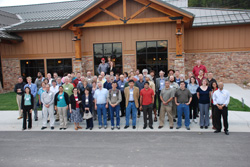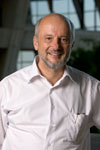|
Have a safe day!
Tuesday, June 15
12 p.m.
Summer Lecture Series - One West
Speaker: Arden Warner, Fermilab
Title: Accelerators
3:30 p.m.
DIRECTOR'S COFFEE BREAK - 2nd Flr X-Over
THERE WILL BE NO ACCELERATOR PHYSICS AND TECHNOLOGY SERMINAR TODAY
Wednesday, June 16
3:30 p.m.
DIRECTOR'S COFFEE BREAK
4 p.m.
Fermilab Colloquium - One West
Speaker: Hari Manoharan, Stanford University
Title: Quantum Imaging of Dirac Materials
Click here for NALCAL,
a weekly calendar with links to additional information.
Upcoming conferences |
|
For information about H1N1, visit Fermilab's flu information site.
|
|
Tuesday, June 8
- Bagel sandwich
- Chicken and rice soup
- Italian sausage w/peppers and onions
- Smart cuisine: Beef stroganoff
- Smart cuisine: Chicken lemon
- Peppered beef
- Assorted slice pizza
- Chicken tostadas
Wilson Hall Cafe Menu
|
|
Wednesday, June 16
Lunch
- Spicy sausage and cheese stuffed portobello mushroom
- Baby greens w/mango and marinated onions
- Fruit tart
Thursday, June 17
Dinner
- BOOKED
Chez Leon Menu
Call x3524 to make your reservation. |
|
|
LBNE collaborators discuss project details in Deadwood
 |
| LBNE collaboration members at their meeting in South Dakota. |
During the last week of May, residents of the small mining town of Deadwood in the Black Hills of South Dakota found themselves surrounded by scientists from the Long-Baseline Neutrino Experiment (LBNE).
The scientists converged on the tiny 1,400-resident town of Deadwood for their collaboration meeting, which focused on beginning the process of choosing a configuration for the project.
Although Deadwood is famous for its gold rush in the late 1800s, LBNE scientists aren’t there looking for gold – they’re hunting for elusive neutrinos. The proposed LBNE experiment would use protons from Fermilab’s Main Injector to create a neutrino beam that would travel through the Earth to large neutrino detectors in the NSF’s proposed Deep Underground Science and Engineering Laboratory (DUSEL) in the nearby Homestake Mine.
LBNE received DOE’s CD-0 approval in early January, establishing the project’s mission need, and is now preparing for CD-1 review in December when the project will present its Conceptual Design Report (CDR). Depending on funding, construction could start in 2015 and start of operations in 2020.
"Over the next couple months, the collaboration will focus on putting together a science report to evaluate the scientific sensitivities and costs for all potential variants of the experiment - what type of beam and detectors to use and how deep underground the detectors should be," said LBNE co-spokesperson Robert Svoboda.
To produce the report, the collaboration established a physics working group for each major area of study. The collaboration's science report will provide input for the project's CDR.
Read more |
URA Thesis and Tollestrup prizewinners
 |
| Justin Evans of University College London receives the Tollestrup award from Alvin Tollestrup. Evans received the award for his contributions to measuring neutrino and antineutrino oscillation parameters with the MINOS experiment. |
 |
| Fred Bernthal, URA president, gives the URA Thesis Award to Tingjun Yang. Yang's thesis was entitled "A study of Muon Neutrino to Electron Neutrino Oscillations in the MINOS Experiment." |
|
Unexpected antineutrino masses a puzzler for Standard Model
From Ars Technica, June 14, 2010
Two weeks ago, experimental results seemed to indicate that we're getting a handle on the low-mass particles called neutrinos. Today, Fermilab announced results generated using antineutrinos that suggests we may need to make major revisions to the Standard Model of physics. The textbook description of antimatter is that it's like a mirror image of more familiar particles. But new work from Fermilab indicates that the mass differences among antineutrinos aren't the same as those for regular neutrinos. If the findings hold up, they would call for some new physics to explain the discrepancy.
Like the earlier results, the new data relies on observations of neutrino flavor changes. Neutrinos and antineutrinos, unlike other particles, appear not to have a fixed nature. They exist as a mixture of three identities—electron, muon, and tau—and a given particle oscillates among these identities in a probabilistic manner that depends in part on the mass differences among the three classes. So, if we can observe these oscillations, we can get some indication of the relative masses of these extremely light particles.
Read more
|
Aspirin and dental floss: Homespun high-energy physics
From New Scientist, June 15, 2010
As the first physics results begin to emerge at the expensively engineered and hugely complex Large Hadron Collider, New Scientist looks at the everyday equipment that particle physicists couldn't live without - from aspirin to dental floss.
Aspirin tablets
Aspirin cures a different sort of headache for the engineers at Fermilab in Batavia, Illinois.
In Fermilab's particle accelerator, components called radio-frequency (RF) cavities generate an alternating electric field that pulls and then pushes bunches of charged particles as they pass through the accelerator. Leaks in the cooling system can drip water into the RF cavities, which could cause an electrical arc that would damage the accelerator hardware. But radiation stops technicians making repairs while the accelerator is running.
In the mid-1970s Fermilab engineers came up with an ingenious way of detecting leaks before they caused problems. They placed an aspirin tablet over a hole at the lowest point of the accelerator cavity, with part of an electrical switch holding it in place. When water dissolves the aspirin away, the switch is tripped and shuts off the high voltage in the RF cavity.
"It turned out that the aspirin tablets were the most reliable of methods tried," says John Reid of Fermilab.
Read more
|
|
|
Goings on in D.C.
 |
| Fermilab Director Pier Oddone |
Last week I spent three days in Washington D.C., all of them, as always, interesting, although they were also sobering.
On Tuesday I attended a day-long meeting with Secretary Steven Chu and all the lab directors. At the meeting we discussed many issues that cut across the Department of Energy laboratory system from strategy to sustainability to bureaucratic reform. Secretary Chu and Deputy Secretary Daniel Poneman are leading an effort to simplify and streamline the many requirements that DOE imposes on the laboratories, a formidable undertaking especially when the department today is called upon to act across many fronts. One such front is the oil spill in the Gulf. Secretary Chu is leading a technical group to advise the government and BP on technical issues, in particular rallying the DOE technical expertise to make quantitative measurements, modeling the geology and flows, anticipating what can go wrong in future actions and mitigating the risks. Much remains to be done in this area before the situation is brought under control.
On Wednesday I visited the Office of Science and Technology Policy (OSTP), the Office of Management and Budget (OMB) and several Congressional offices. The mood is quite somber as the government tries to rein in budget deficits. Furthermore, there is a universal consensus that we will not have appropriations bills until after the November election. The difference in funding between a continuing resolution and the President's budget request is not huge. However, it will create a very significant gap, at least through the beginning of the fiscal year, especially as we try to run the Tevatron for the full year and keep the momentum up on the new initiatives.
The brightest spot of the trip was on Thursday when we presented our strategic plan and our current performance to the leadership of the Office of Science, including the program managers of the various offices, Director William Brinkman and Deputy Director Pat Dehmer. We received uniformly positive comments on our plans and on how we are conducting our program. This is the best defense for sustaining our particle physics program. One important comment we received expressed the appreciation that the Office of Science has for having a single program laboratory like ours devoted to particle physics. We have a challenging and rewarding field that requires focus. As a result, our laboratory has a distinct footprint from all other laboratories, many of which overlap in aims and programs. We continue to show our sponsors and the public the value and excitement of the fundamental research we do.
|
West Wilson Hall parking lot repairs begin Tuesday
Pavement repairs to the Wilson Hall west parking lot begin today. Roads and Grounds staff expect that the work will take two to three days.
Repair operations will block some parking areas, so some employees may need to use the Lederman Science Center lot for overflow parking. Temporary overflow parking signs will guide drivers. Traffic in the west lot may also be delayed at times by flaggers.
Inclement weather could affect the repair schedule this week. Please watch Fermilab Today for further updates. |
|
June 11-14
- Five stores provided ~53.5 hours of luminosity
- Recycler personnel reset the Pelletron blower
- TeV sector E2 wet engine repaired
- TeV vacuum pumps repaired
- Feeder 97 reset
- Operators raised the H- Source pressure
* The Integrated Luminosity for the period from 6/7/10 to 6/14/10 was 63.46 picobarns. NuMI reported receiving 7.37E18 protons on target during this same period.
Read the Current Accelerator Update
Read the Early Bird Report
View the Tevatron Luminosity Charts |
|